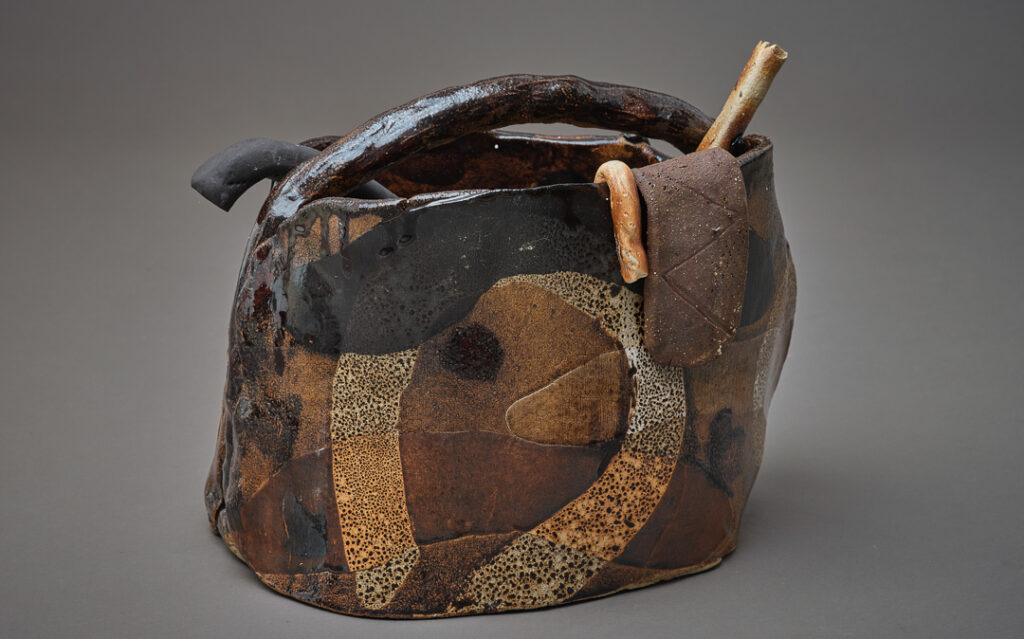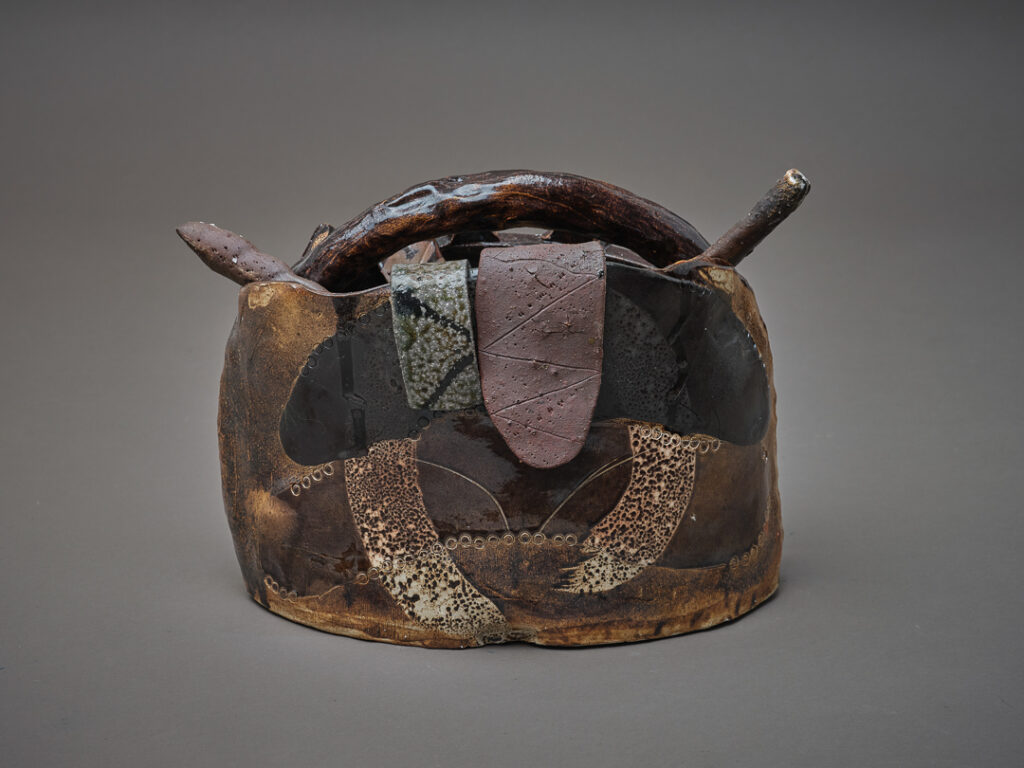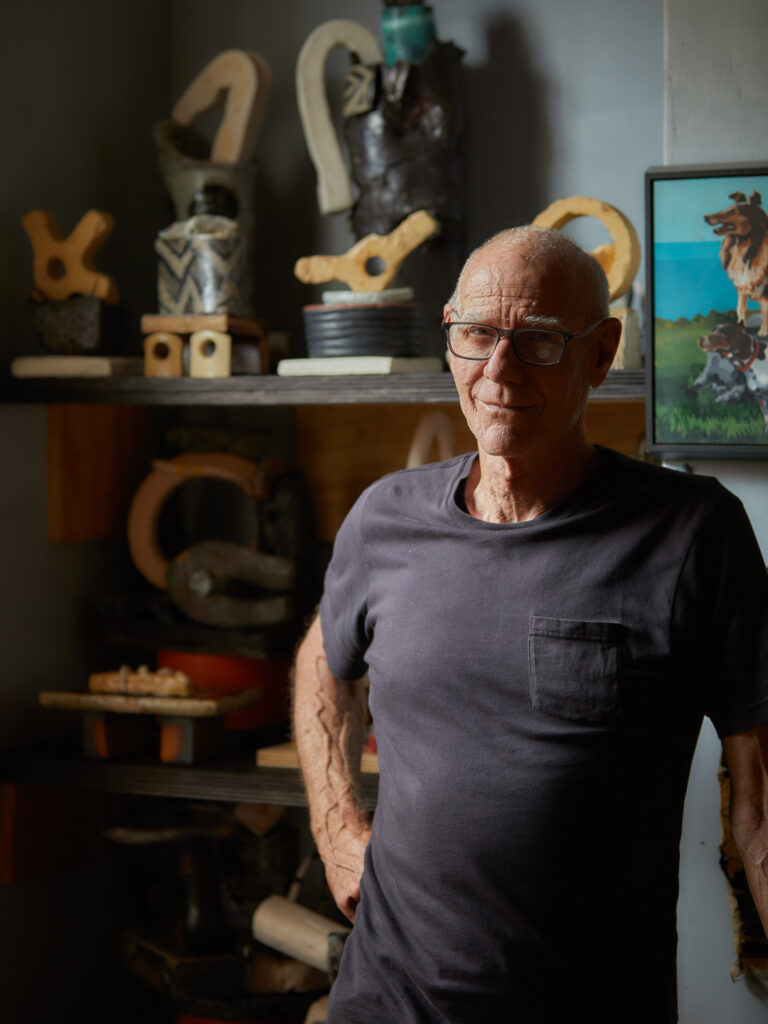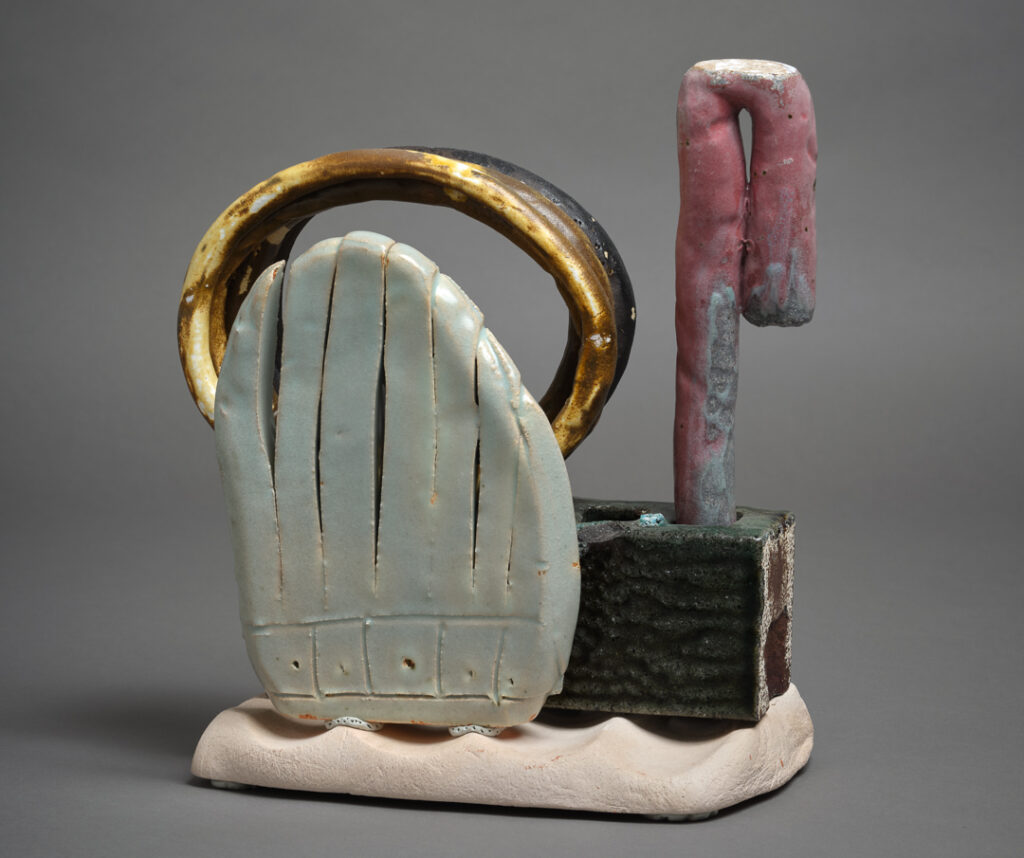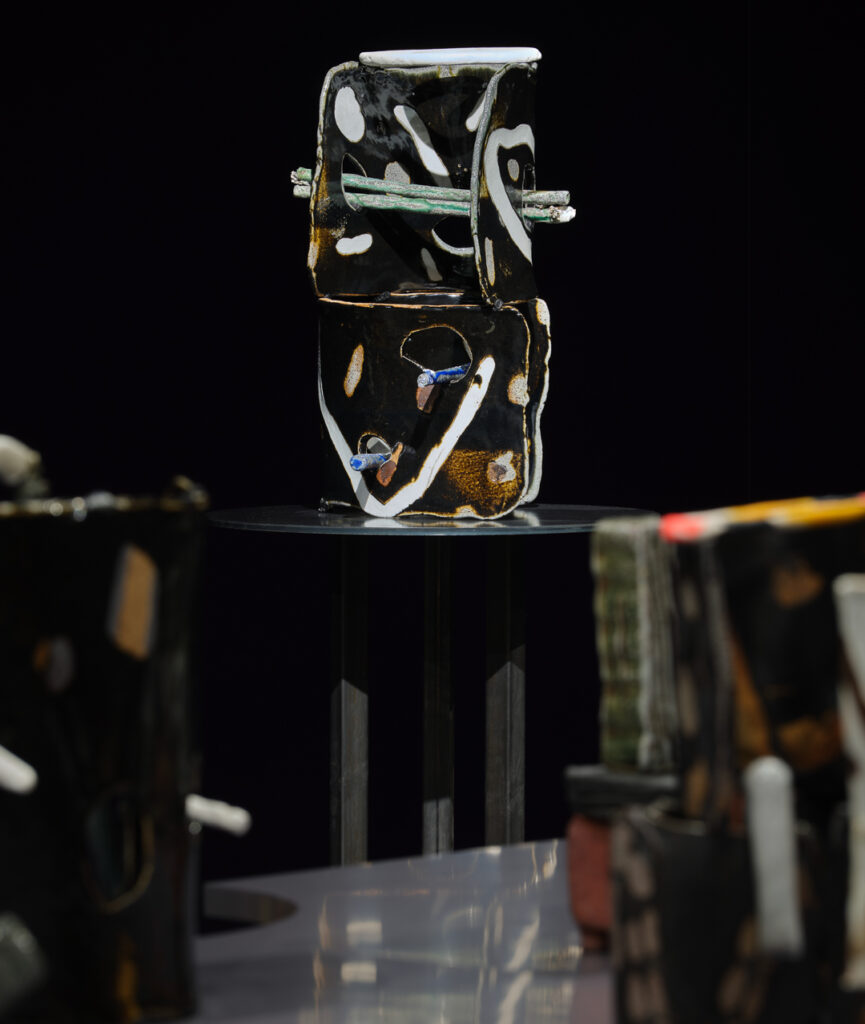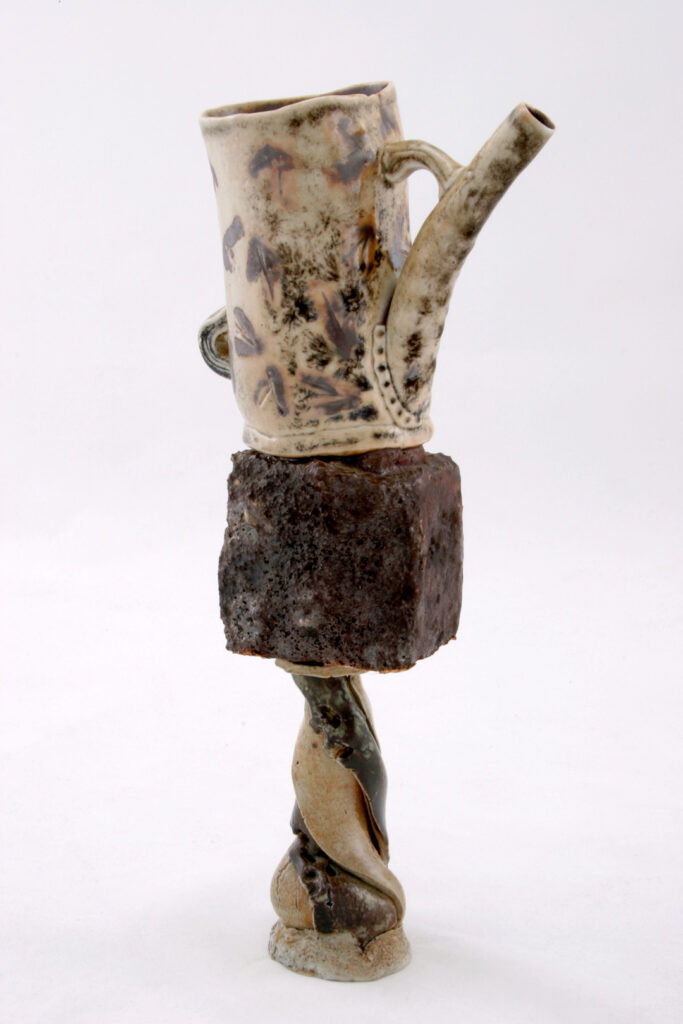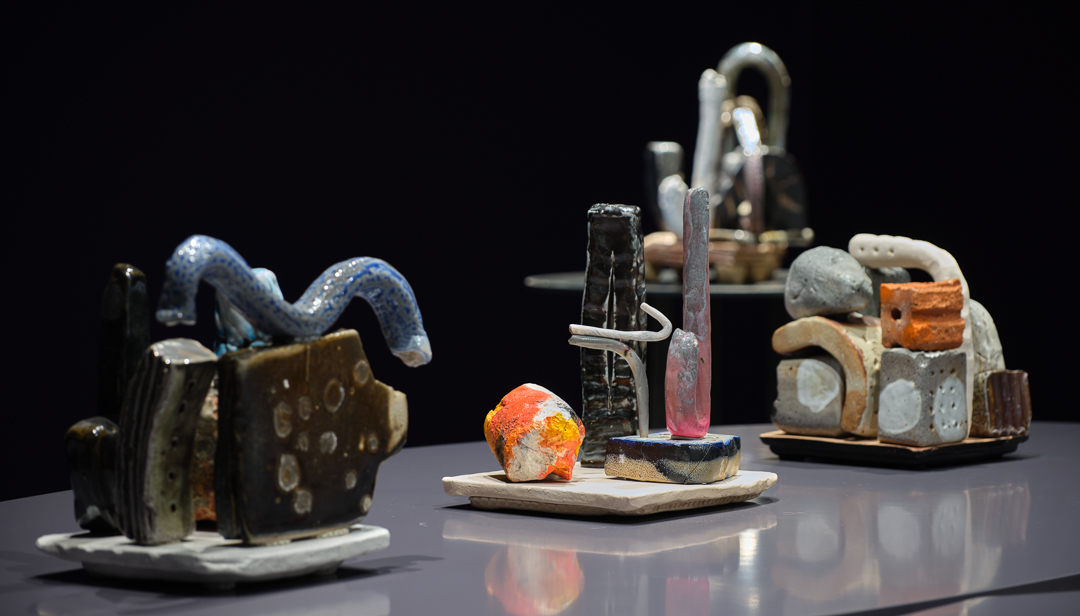
Peter Hawkesby, Tender Brick exhibition, 2021, courtesy of the artist and Anna Miles Gallery (installation view); photo: Sam Hartnett
Lucy Hammonds writes about a New Zealand ceramicist whose work is grounded on the land he walks.
Earlier this year, as the southern autumn gave way to winter, I made my first visit to the studio of Peter Hawkesby. While mutual friendships had previously thrown us into orbit, this was my first opportunity to meet Hawkesby in his workshop since he had made the move from Tāmaki Makaurau Auckland to Ōtepoti Dunedin, one of Aotearoa New Zealand’s southernmost cities. A classic ceramicist’s shed, his studio perches above an industrial lot in a central city suburb: concrete and corrugated iron are punctuated by deposits of clay in assorted buckets and bags.
My first encounters with Hawkesby’s ceramics came through the lens of art history. His hand-built teapots, cups and incinerators from the early 1980s sit amongst museum collections like punks at a conservative party conference—anarchistic, unpredictable and totally compelling. Within the recent history of ceramics in Aotearoa, Hawkesby is one of the radicals. Briefly flirting with life as a rural studio potter in the 1970s, he soon realised that he got “no thrills whatsoever” from a life producing domestic wares for a ready market and went looking elsewhere. Turning away from the wheel and the stability of the studio, Hawkesby followed a path that led to Waiheke, an island in the Hauraki Gulf that, at the time, was an enclave for those seeking alternatives. A bush-clad island, seamed with clay, it was here that Hawkesby found his artistic voice. His work was wrong in all the right ways, and he was recognised as a singular figure in a crowded field of ceramics. Five decades on from the time when Hawkesby first plunged his hands into a lump of clay, his works still brim with this energy. Despite moving south for a slower, more sustainably-paced practice, the most recent phase of his career has been marked by an outpouring of ideas, his studio shelves stacked with works at all stages of completion.
Hawkesby’s are works to be “visually felt”…
Hawkesby’s works are typically handbuilt compositions of assembled elements. Although primarily sculptural, their formal and material language is one of intimacy. The way Hawkesby brings the different parts of his work together encourages thinking about the relationships between object and body. His works are recognisably domestic in scale and form, with loops and swishes of clay, and stacked, squashed and overlapped elements. They are made through push and pull: their curves, cracks, cuts and joints trigger the muscle-memory of rolling, kneading, cutting, pinching, and squeezing. As Richard Fahey, a writer and curator, once wrote, Hawkesby’s are works to be “visually felt”, the eye “translat[ing] in purely abstract terms a bodily experience.”
- Peter Hawkesby, from the Heart Basket series, 2023, courtesy of the artist and Anna Miles Gallery; photo: Sam Hartnett
- Peter Hawkesby, from the Heart Basket series, 2023, courtesy of the artist and Anna Miles Gallery; photo: Sam Hartnett
- Peter Hawkesby, from the Heart Basket series, 2023, courtesy of the artist and Anna Miles Gallery; photo: Sam Hartnett
Following this idea that Hawkesby’s work has a transformative quality, translating visual into tangible, then his most recent “Heart Baskets” (2023) can be thought of as a recasting of experience as form. On my first visit to Hawkesby’s studio, the “Heart Baskets” remained unfinished. Unglazed and waiting on a lower shelf, the works were in a state of suspended reality and he was still processing their next steps. Hawkesby explained the origin of the works, and how they had been made over a period in which he was experiencing a slow-moving heart attack. It wasn’t until later that he became fully aware of this cardiac episode, and so the works became an object-based record of this time. With a central structure bracing an enclosed internal void, the Heart Baskets are open, basket-like forms. They are squat and grounded, with side panels wrapping around a solid central handle. As Hawkesby described making the works during this cardiac event, parallels arose between form and experience: the sculptural language of the Heart Baskets echoes the unique conditions of their making.
Returning to Hawkesby’s studio several months later, the “Heart Baskets” had been completed. Glazed in shades of black and brown, the body of the baskets had developed into a patchwork of texture and tone. They are unified by a central handle, which binds together the internal skeleton, creating a structure to which the side panels attach. This makes the handle important, both compositionally and conceptually. Talking about these works, Hawkesby made connections between the handle and physical expressions of strength. Thinking about this in relation to ideas of touch, which are guiding this particular discussion of Hawkesby’s work, the “Heart Baskets” remind us that there are few things more reassuring, more dependable, than a sturdy handle to grip.
While Hawkesby’s “Heart Baskets” are held together by a strong handle, they are bottomless. They hold nothing more than an empty void, an assorted cast of additional elements slung over the side panels, or propped up against them. This assembly of loose parts has other stories to tell, other ways to think about the relational nature of ceramics. Hawkesby moved to Ōtepoti from Tāmaki Makaurau, where he had easy access to the abundant clay deposits of that region. Arriving in Ōtepoti, he discovered that it was more difficult to locate workable clays directly from the land. Gathering, storing and exchanging clay with other artists, he has gradually built up his resources, creating a material library that is rich with embodied stories of time and place, of geology and geography.
While finishing the “Heart Baskets”, Hawkesby had returned north to Tāmaki Makaurau, tacking on an extra day and an extra bag in order to bring back clay from Waiheke, his former island home. Traversing the familiar coastline hunting for clay, Hawkesby found the landscape had been significantly impacted by the cyclone damage that ravaged parts of Aotearoa earlier in 2023. Wading along the beach, fearing his expedition might prove fruitless, he felt clods sticking to the soles of his shoes. These clumps of waterlogged clay had been dislodged by slips and were now dispersed across the sandy foreshore. Gathering a small supply, he transported this back to Ōtepoti where it was worked into the loose elements of the “Heart Baskets”. Hawkesby pointed out that the qualities of the clay came from this particular location, the unique colours of the clay, and the textures of shell fragments that had revealed themselves during firing. The patchwork of the works was transformed into a topography, the clay itself mapping a journey from north to south shaped by the intimacy of a maker’s understanding of their material.
In our last conversation about these works, Hawkesby had brought his set of three “Heart Baskets” into the back room of his studio, setting them amongst other works that were being prepared for a forthcoming exhibition. While they spoke in the same formal language as his wider practice, these works felt as if they were in a different conversation. Hawkesby’s work is full of energy and movement, with different forms, colours, tones, and textures coming alive and interacting within his works. The “Heart Baskets” have a different tenor, their quieter nature inviting the viewer into their depths. Despite being born out of times of turbulence and change, they feel stable and anchored, offering a safe harbour when wild weather is on the horizon.
- Peter Hawkesby 2019 courtesy of the artist and Anna Miles Gallery: photo: Sam Hartnett
- Peter Hawkesby Nasturtium Dance 2020 courtesy of the artist and Anna Miles Gallery; photo: Sam Hartnett
- Peter Hawkesby Cook Strait Te Moana-o-Raukawa 2020 courtesty of the artist and Anna Miles Gallery photographer Sam Hartnett
- Peter Hawkesby, Brick Teapot, 1980
Further reading
Tender Brick: The Material Epiphanies of Peter Hawkesby
About Lucy Hammonds
 Lucy Hammonds is a Curator at Dunedin Public Art Gallery, one of Aotearoa New Zealand’s metropolitan art galleries. She was previously Curator of Art and Design Collections at Hawke’s Bay Museum and Art Gallery/MTG Hawke’s Bay, and trained in the Critical Studies programme at Unitec School of Design, Tāmaki Makaurau Auckland. Lucy currently lives in Ōtepoti Dunedin with her family, where much of their spare time is spent exploring the beaches and mountains of Te Waipounamu, the South Island.
Lucy Hammonds is a Curator at Dunedin Public Art Gallery, one of Aotearoa New Zealand’s metropolitan art galleries. She was previously Curator of Art and Design Collections at Hawke’s Bay Museum and Art Gallery/MTG Hawke’s Bay, and trained in the Critical Studies programme at Unitec School of Design, Tāmaki Makaurau Auckland. Lucy currently lives in Ōtepoti Dunedin with her family, where much of their spare time is spent exploring the beaches and mountains of Te Waipounamu, the South Island.

